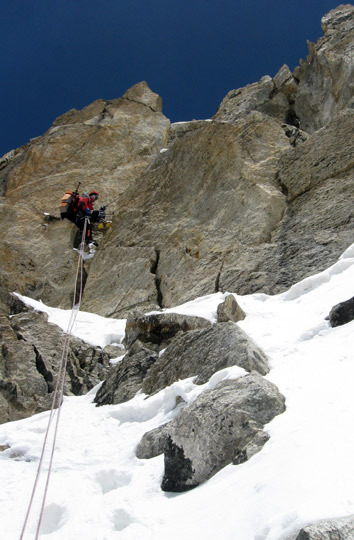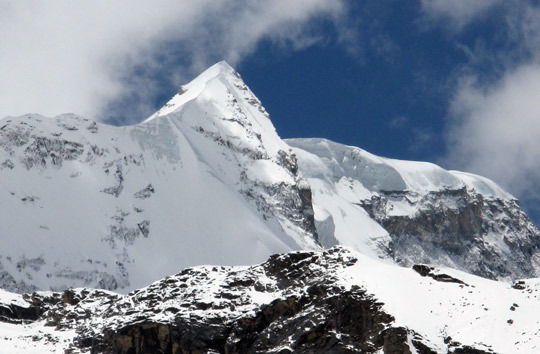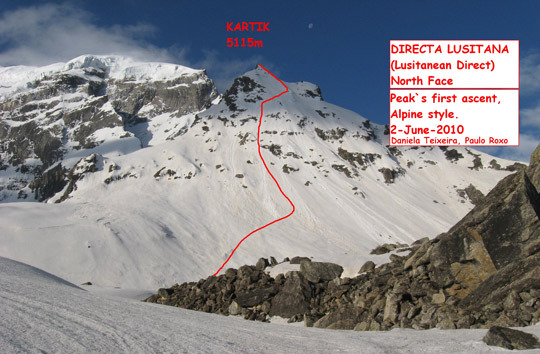
Daniela Teixeira rappels off the north face of Ekdant (6100m) during an exploratory mountaineering trip in the Garhwal region of the Indian Himalayas in May and early June. She and Paulo Roxo, both from Portugal, climbed some new ground in the rarely visited area. [Photo] Paulo Roxo
In an effort to get away from the crowds gathering this spring on other Himalayan peaks, Portuguese climbers Paulo Roxo and Daniela Teixeira spent a few weeks in May and early June exploring the remote Garhwal region of the Indian Himalayas. Despite poor snow conditions, Roxo and Teixeira climbed new terrain on Parvati Parvat (6257m) and Ekdant (6100m) and established what they believe to be the first ascent of an unmapped peak, which they called Kartik (5115m).
After arriving in Delhi, India, on May 11, Roxo and Teixeira spent two days driving and two days trekking to access the 6000m mountains that hadn’t seen a climbing expedition since 1980, Teixeira reported. Little is known about the region and the climbers had collected all the information they could, which amounted to a few pictures found online and a 1:125,000 scale map.
At 3 a.m. on May 21, Roxo and Teixeira departed base camp (4200m) for their summit push on Parvati Parvat. Their map indicated they would need to climb a spur and cross a plateau to reach the summit, a trek they estimated would take two long days. On the first day, they climbed the less steep portion of the spur, but deep snow slowed their progress. They pitched a tent at 5450m around noon and rested. On May 22, they started at 1 a.m. with hopes to reach the summit by 10 a.m. At 7:30 a.m., they reached a snow dome at ca. 6150m only to find that at the other end of the plateau, obstructing them from the summit, was another sharp peak that had not been indicated on their map. Content with their high point, the team descended.
After turning back, Teixeira and Roxo looked at a prominent triangular peak they passed on their way up Parvati Parvat and decided to climb it instead, thinking it might be unclimbed. “With renewed happiness,” Teixeira said, they descended back down the plateau and climbed the slope following their own footsteps save for the last few meters to the summit.

Roxo and Teixeira established a new route up Ekdant, shown here, after turning back on their attempt up Parvati Parvat (6257m). [Photo] Daniela Teixeira
For their descent, the team had only a 50-meter rope, which meant they could only rappel 25 meters at a time, mainly on abalakovs. The next day they reached base camp after a long descent in deep snow, sometimes up to chest level. Back at base camp they learned this peak was called Ekdant, and while it had previously been climbed by two Indians in 1980, Roxo and Teixeira had ascended from a different aspect.
After a few days of bad weather, Teixeira said they tried Parvati Parvat again, following another route on the north face, but bad snow conditions and avalanche danger turned them back at 5100m.
On June 2, with one more day of good weather remaining, Roxo and Teixeira turned their eyes to Kartik, an unmapped peak visible from base camp. They climbed in alpine style, finding rotten snow before summiting at 10 a.m. Teixeira said the peak was fun, the crux being a bit of easy rock climbing at the very top.
Teixeira said she was happy to climb the first Portuguese summit in the Himalayas. They named their route Directa Lusitana, and named the peak Kartik, the small warrior son of Lord Shiva and Parvati (Shiva’s wife), and the brother of Ekdant.

Topo of Ekdant indicating Roxo’s and Teixeira’s route on the North Spur, which they climbed May 21-22, 2010. [Photo] Daniela Teixeira

Kartik (5115m), a peak not indicated on the the pair’s map, they climbed alpine style via a new route, Directa Lusitana, on June 2. Teixeira believes that she and Roxo were the first all-Portuguese team to climb a virgin Himalayan summit. [Photo] Daniela Teixeira